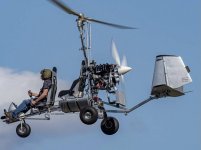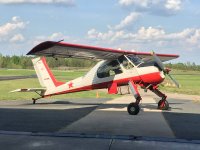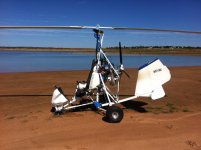Dave.
Now I am a simple man from a small village on a remote island thus can only give you simple practical findings & opinions. If I had 1% of the aeronautical design and theory knowledge of some on here I would be doing well.
With regards to stability etc I have only flown the Sportcopter for 120 hrs and only 50 of those with the 26” rears and the 17” nose wheel assy. So still getting the hang of things regarding independent braking and full castering nose wheel etc so have not yet given it the opportunity to realise its potential in the back country flying that I do. When this Covid is sorted maybe you should come down & fly it. You might then go home and get back into an SC. You also may develop a liking for vegemite sandwiches.
As Fara says the bigger tyres have raised the vertical CofG higher above the ground. Would it be fair to say though countering that is the wider footprint. Also still experimenting with the best combination of tyre pressure & suspension spring settings. It does get the leans a bit with taxi manoeuvres on sloping ground. Maybe I just need to park it on a good slope and stand on a wheel and rock the hang out of the mast to boost my confidence of its reluctance to topple over. Also am looking at better brakes for the higher end pre rotations. Am in the process of making up a suspension nose assy with a fully adjustable Fox air shock. If that works out well will fit to the Magni also. As Wolfy states above, the custard starts with the nose wheel, and ask me how I can confirm that.
I know there have been numerous discussions on this forum regarding linked verse castoring nose assys. Its very interesting having one of each and at this stage I am on the fence as to which I prefer. Maybe in time I will make up a nose wheel lock and have the best of both worlds. I have no axe to grind in that debate & will simply do what I find works best for me. Or will leave each as they are and enjoy & appreciate the differences.
The Magni with the 26” rears and SC 17” nose assy I have put 1,000 hrs on & all in the back country, the tyres have never seen pavement.
I had best have some reference to fixed wings or may be accused of thread drift.
I have never flown a fixed wing other than hanging under helicopters & in need of repair. In fact last time I was in a 185
size plane was 40 years ago and that was before my helicopter career started so was pretty oblivious to all goings on.
I actually suffered from serious motion sickness whenever in one but will sometime pluck up the courage again as I am keen to see how much bouncing they experience on rough ground & how they handle side slope.
Dave so straight up, taking off on undulating ground with humps and hollows can be a ride for sure. Especially if no wind, as the sooner that nose wheel is off the better. Also if you hit a good hump just before the two ingredients needed to break free of the ground(say 27 kts & 270 rpm) bounces you into the air prematurely & then say only one wheel hits the next hump that can be a bit disconcerting.
This is where I am finding the Sportcopter suspension and bush tyre combination better. The Magni glass leaf spring strut does not have much give and you can feel a jar & quite a lateral attitude change & with that the other can hit & develop a tap dance situation. In saying that folks idea of what constitutes as rough ground differ I am sure.
As Fara also states the weight of all of that spinning stuff high up there may not be helping.
In saying all that I have oodles of country where I can land without having to put man & machine through undue stress. After all I am out there to enjoy & nothing to prove to anyone but myself.
Smoother gravel bars are fine. For the bigger rocks I like some wind to help get that nose wheel off earlier.
Remember big rocks to me are nothing like “Maule Guys”youtube videos with his 35” bushies.
For me generally baseball sized stuff with football sized sprinkled through. One advantage with the gyro is can flop onto a small spot with zero forward roll & then do some gardening with the fold up army shovel or drag a few logs away for take off.
Beaches & river silt I find can be either super easy or very challenging. A large area I fly in is wilderness with landings only permitted below high tide. Which includes tidal areas up suitable rivers. This coastline is battered by our predominant SW weather so the few beaches that there are are changing constantly. This area receives close to 7 meters of rain per annum so the river beds constantly changing also.
Slope on these beaches can be challenging. Obviously if the tide is out then an angled take off lessens the degree of slope.
Some below high tide are so hard packed you cannot even see your wheel marks, perfect. But others have small custard soft patches & not always in the same area, & we know nose wheels do not do custard soft well. Especially with a high power setting & thus considerable down force on the nose wheel due to the prop thrust to wheel couple & possibly 5 or six hours fuel on, & an few extra vegemite sandwiches as usually an all day affair when down there.
With the lateral slope take offs I have found a similar technique to a helicopter works best for me.
So if able left wheel on the down slope. Degree of slope depends on the cross wind direction if any. Up slope wind considerably better than down slope as it is all about up slope stick / disc effectiveness to be able to lift the low side wheel.
So spun up and stick full aft and ample up slope. During the roll I do not let the nose wheel come up until I have been able to lift the low side wheel off the ground and now level & from there its a normal take off. Now this is with the linked nose wheel. If the down slope wheel wont come up then I abort & come up with another plan. Last resort some serious benching with the army shovel.
If I let the nose up first and loose that link advantage then I find there is a good tendency for everything to start tracking down slope rather rapidly & in my case could be into into the sea.
I have not yet done much of this in the Sportcopter. Am thinking the castor will make the nose want to fall down slope so tabbing the up slope brake will be necessary for most of the roll. Will see how that works out in the future.
Its about a 150 mile stretch of coastline to the south of my hangar & 40 miles wide of mountains, bush, fiords & some amazing glacier valleys. So a great gyro play ground on a fair to good weather day. Absolute therapy.
This is where the Magni shines, as I can have my aux tank in the back giving me the 6 hrs. Also a fuel stash at mile 50 helps. It is also more stable in the wind & it sure can blow down there.
Dave sorry to drag on but hope this answers some of your questions. But also in relation to this thread topic for others interested I wanted to explain a bit about what I get up to because in my opinion gyrocopters can make quite good back country machines. Sure not the load carrying capacity of some of our bigger fixed wing brothers, but hey for that I can fly in the Skycrane and take 10 tons vertical. But seriously horses for courses, & the videos I see of guys playing around with their planes on gravel bars for recreation I am happy doing similar. In play mode with say 1 hrs gas & no wind I work on a 60 meter ground roll. 15 kts of wind & under half that. Also to me its not just about take off and landing rolls etc etc, equally important is the quality of the flying. In that sort of country I am flying in it not over it. Being able to fly up box canyons and turn on a dime at the end, vertical descents down beside waterfalls, over mountain passes and back to idle and 25 kts & enjoy a nice quite 700 fpm descent into the valley. Sometimes I will fly a full fuel load (6hrs) with no landings and still enjoy the heck out of it. I understand flying in hostile country with no suitable landing places for maybe 40 miles and lots of eight eights bush is not to everyones liking. To me however I am prepared to take the associated risks. I have spent many years in helicopters hovering over 200’ + jungle extracting logs and drilling equipment whilst relying on countless more nuts, bolts, bearings & components compared to those in the relatively simple design of a gyro. A well maintained Rotax is probably the most reliable engine I have flown.I have had 15 engines fail in helicopters & 3 major drive train failures.
Don’t get me wrong I do not go out and simply temp fate. But if ok with the risk then I take it. Am well prepared though.
Always wear a high quality full dry suit, life jacket, often carry small single man raft, 2 PLB’s. A spot tracker and satphone. Heated under clothes for the winter & extra lipo battery that would get through a night if say stuck above the snow line.
A mate has a Magni M22 915 arriving next month which we will also fit with the 26”kit etc. It will reside in my hangar so I will get to fly that quite a bit. Will be interesting.
Another mate has a Sportcopter M2 on order with the Aeromomentum so that thrown into the mix will be even more interesting.
And Sanman I hope this adds to some of your understanding.
Will hit post on this then add some pics separately later, as with my computer skills I am likely to lose what I have written.
Cheers
Pete



